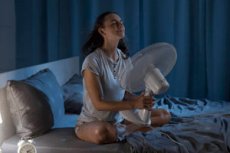New publications
Study shows that nighttime heat significantly increases stroke risk
Last reviewed: 02.07.2025

All iLive content is medically reviewed or fact checked to ensure as much factual accuracy as possible.
We have strict sourcing guidelines and only link to reputable media sites, academic research institutions and, whenever possible, medically peer reviewed studies. Note that the numbers in parentheses ([1], [2], etc.) are clickable links to these studies.
If you feel that any of our content is inaccurate, out-of-date, or otherwise questionable, please select it and press Ctrl + Enter.

A recent study by researchers from Helmholtz Munich and the University Hospital Augsburg, led by Dr. Alexandra Schneider, showed that nighttime heat significantly increases the risk of stroke. These findings could contribute to the development of preventive measures that could help the population better protect itself from the risks associated with climate change and increasingly frequent hot nights. In addition, knowledge of the effects of hot nights could improve patient care.
"We wanted to understand to what extent high night temperatures pose a health risk," says the head of the working group for environmental risk research at Helmholtz Munich. "This is important because climate change is causing night temperatures to rise much faster than day temperatures."
Data on 11,000 strokes over 15 years
In their study, published in the European Heart Journal, the researchers analyzed data from the University Hospital Augsburg. Its neurology department collected data on about 11,000 strokes over 15 years. The analysis shows that extreme heat at night increases the risk of stroke by 7%.
"Older people and women are at particular risk, and it is mainly mild strokes that are diagnosed in hospitals after hot nights," said lead author Dr Cheng He. "Our results clearly show that adjustments to urban planning and health care are essential to reduce the risks associated with rising night temperatures."
"We were able to show that the risk of stroke associated with high night temperatures increased significantly between 2013 and 2020 compared to the period between 2006 and 2012," emphasizes Professor Michael Erl, head of the Stroke Department and the Neurovascular Research Working Group at the University Hospital Augsburg. From 2006 to 2012, hot nights led to two additional strokes per year in the study area; from 2013 to 2020, 33 additional cases were recorded per year.
Recommendations for adaptation strategies and urban planning
The researchers plan to make their findings applicable in practical settings. To this end, they are working on recommendations for adaptation strategies for the public and urban planning, such as reducing the intensity of urban heat islands. The goal is to better protect the population from the effects of nighttime heat.
The study will also serve as a basis for further research into developing targeted preventive measures against factors that contribute to stroke. "The earlier these preventive measures are implemented, the better," Schneider says.
The study's findings also have important implications for hospitals. They will be able to better adapt to the incidence of strokes in the future: if the weather forecast predicts a hot night, hospitals can expect more stroke patients to be admitted. This allows hospitals to plan ahead for an increase in staff to care for patients, explains Professor Markus Naumann, director of the Neurological University Hospital in Augsburg.
Background: What are tropical nights?
"Tropical nights" are defined using what is known as the "Hot Night Excess Index" (HNE). This measures how much the temperature rises above a certain threshold at night. The threshold is the temperature that is exceeded on only the 5% of the warmest nights over the entire study period.
In this study, this value is 14.6°C. If the temperature at night rises above this value, it is classified as a tropical night. The HNE index adds up how many degrees the temperature exceeds this threshold during the night hours to determine the intensity of the heat.
